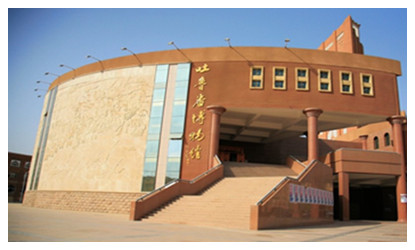Skype: neodalle-travel
Tel: +86 135 7447 2266
E-mail: sales@visitaroundchina.com

What to see ?
There is a 56-meter-high sightseeing tower in the northeast corner of the museum, a four-storey training center, etc. However,Turpan Museum is regarded as the second largest museum in Xinjiang only after Xinjiang Regional Museum.
General History of the Turpan Area
This exhibition hall is mainly to show selected cultural relics that have been unearthed, levied, picked and donated since the founding of the People’s Republic. There were human traces in this area as early as the Stone Age. It entered the Bronze Age about three thousand years ago. The Han Dynasty (206BC-220AD) first annexed it to China’s territory in 60BC. About 400 years later, the Gaochang Prefecture and the Gaochang Kingdom were established here successively. It returned to the central government of China when the Tang Dynasty (618-907) united the nation. The ancient Uighur Empire was established in 840… Turpan’s history is created by people of different tribes and ethnic groups (including some from Central Asia), cultures and religions. The 900-square-meter (1,116-square-yard) exhibition hall means to represent panoramic picture of the region.
Giant Rhinoceros Fossil Exhibition
About 20 million years ago, the giant rhinoceros (Paraceratherium, also commonly known as Indricotherium or Paraceratherium), the largest land mammal ever known, lived in the area which was thought to be a sea, but dramatically to be a dessert now. It is said that it could eat about 500 kilograms (1,102 pounds) of leaves or grass every day. It is 5 meters (about 5 yards) high, and 9 meters (about 10 yards) long, with a weight of 30 tons (about 66,139 pounds). The fossil skeletons here are the most complete giant rhinoceros fossil ever excavated. Fossils of rhinoceros and other creatures in remote geologic ages are displayed with the aid of pictures, models, short films and videos, in order to give a vivid interpretation of the scene in millions of years ago.
Ancient Mummy Exhibition
This is the most mysterious and attractive part of the museum. The mummies discovered in the area are bestowed by local geography and climate, like being dried by the Flaming Mountain. Numerous mummies had been found in Turpan, which is the main source of mummies in the Xinjiang Regional Museum and other museums nationwide. There are nine well-preserved mummies and one skeleton on display, including two couples and a Shaman witch. The earliest one is the body 3,200 years away. Accessories include burial objects, mural paintings, replica of graves, silk paintings.
Excavated Documents and Silver & Golden Coins Exhibition
Scripts and documents excavated in the area covered the periods from the Sixteen Kingdoms Period (304-439) during the Jin Dynasty (265-420), to the Yuan, Ming and Qing dynasties. The types include letters, contracts, sutras, list paper of funerary objects, prescriptions and so on. Meanwhile, there are ancient coins found in nearby tombs and silver coins of Sassanid Persia donated by a famous numismatician.
Being on the route of the famous ‘Silk Road’, Turpan assembled traders and monks from western and eastern countries. Therefore, this place is left with abundant multi-cultural relics, which is also due to its special natural conditions: torrid, dry and rainless.Here lists Main Exhibitions Halls
Travel Tips
Add: Gaochang Road in Turpan City, Xinjiang
Opening Hours:10:00-17:00 (Closed on Monday)
Entrance Fee: CNY 0
 Ask Questions ?
Ask Questions ?